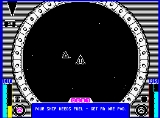
Empire!
Encyclopedia
Empire! is a space combat and trading video game designed by Andrew Glaister
and published by Firebird Software in 1986
for the ZX Spectrum
, Commodore 64
and Amstrad CPC
.
The player can navigate his ship onto a planet's surface through a warp hole (and a tunnel-maneuvering subgame.) Once there, three different supplies can be collected in a first-person
flight subgame. The three supplies – people, minerals and radioactives – are then made available for pick-up in the main playing area and can be transferred back to the starbase.
Players must also defend themselves from constant attacks from enemy alien ships.
Adjacent star systems can be flown to through an asteroid field (represented by square blocks.)
Eventually, the player is able to create a vaccine to combat a plague, which destroys systems 200 stardays from infection. The player can eventually purchase better ships and starbases to form their own empire. The last task of the game is to deploy a defence shield network to secure the player's empire from invaders.
and Asteroids, but games magazines noted that underlying this is a complex game similar to Elite requiring a varied range of skills.
Andrew Glaister
Andrew Glaister, born July 4, 1967 in Marlow, Buckinghamshire, England, is a video game programmer.He initially started programming games on the ZX81 and ZX Spectrum between 1981 and 1987, forming a company called Programmers Development Systems Ltd....
and published by Firebird Software in 1986
1986 in video gaming
-Events:-Notable releases:*Namco releases Sky Kid Deluxe, Hopping Mappy, Toy Pop, The Return of Ishtar, which is the sequel to Tower of Druaga, Genpei Tōma Den, and Rolling Thunder....
for the ZX Spectrum
ZX Spectrum
The ZX Spectrum is an 8-bit personal home computer released in the United Kingdom in 1982 by Sinclair Research Ltd...
, Commodore 64
Commodore 64
The Commodore 64 is an 8-bit home computer introduced by Commodore International in January 1982.Volume production started in the spring of 1982, with machines being released on to the market in August at a price of US$595...
and Amstrad CPC
Amstrad CPC
The Amstrad CPC is a series of 8-bit home computers produced by Amstrad between 1984 and 1990. It was designed to compete in the mid-1980s home computer market dominated by the Commodore 64 and the Sinclair ZX Spectrum, where it successfully established itself primarily in the United Kingdom,...
.
Gameplay
The player is the pilot of a spacecraft, set during a period of early space colonization. There are 64 star systems to explore, presented in a rotating top-down 2D view. Each system has a starbase – which issues missions, receives supplies from the player, and sells various ship add-ons – a sun that presents a navigation hazard due to its high temperature, and one or more orbiting planets.The player can navigate his ship onto a planet's surface through a warp hole (and a tunnel-maneuvering subgame.) Once there, three different supplies can be collected in a first-person
First person (video games)
In video games, first person refers to a graphical perspective rendered from the viewpoint of the player character. In many cases, this may be the viewpoint from the cockpit of a vehicle. Many different genres have made use of first-person perspectives, ranging from adventure games to flight...
flight subgame. The three supplies – people, minerals and radioactives – are then made available for pick-up in the main playing area and can be transferred back to the starbase.
Players must also defend themselves from constant attacks from enemy alien ships.
Adjacent star systems can be flown to through an asteroid field (represented by square blocks.)
Eventually, the player is able to create a vaccine to combat a plague, which destroys systems 200 stardays from infection. The player can eventually purchase better ships and starbases to form their own empire. The last task of the game is to deploy a defence shield network to secure the player's empire from invaders.
Critical reaction
The game's retro sci-fi graphics have drawn comparions with Flash GordonFlash Gordon
Flash Gordon is the hero of a science fiction adventure comic strip originally drawn by Alex Raymond. First published January 7, 1934, the strip was inspired by and created to compete with the already established Buck Rogers adventure strip. Also inspired by these series were comics such as Dash...
and Asteroids, but games magazines noted that underlying this is a complex game similar to Elite requiring a varied range of skills.

